Historical Calendar - 1951
Events
1 January 1951
After advancing south and crossing the 38th Parallel, Chinese forces launch their third-phase offensive against UN troops in South Korea.
3-4 January 1951
UN forces evacuate Seoul as it is captured by the Chinese
13 January 1951
The US delegation votes for a UN cease-fire resolution.
15 January 1951
UN forces continue to bomb Chinese supply lines as the weakening Chinese offensive is brought to a halt south of Seoul.
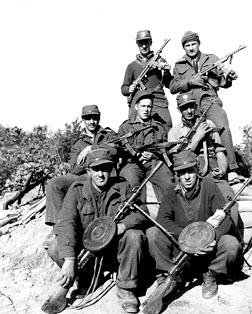
17 January 1951
China rejects a UN cease-fire proposal.
February 1951
Lax regime at the prison camps on Koje-do Island off the southern Korean coast allows Communist prisoners to produce lethal weapons such as spears and knives, which they use to attack camp guards. In one incident US infantry kill 77 prisoners of war and wound 140 for the loss of one of their own men and the wounding of 38 others.

11 February 1951
Communists launch fourth phase offensive in central Korea.
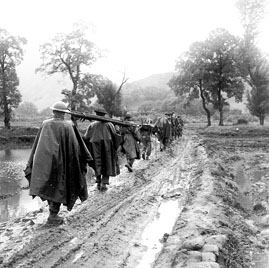
17 February 1951
After two months of training in Korea, 2 PPCLI joins the 27th British Commonwealth brigade.
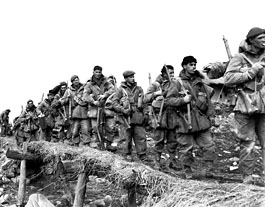
21 February 1951
UN forces launch counter-offensive, Operation Killer, to drive communists north of Han River.

22 February 1951
Four 2 PPCLI soldiers are killed and one is wounded in a two-company attack on Hill 444, the first Canadian battle deaths of the war.

7 March 1951
Two companies from 2 PPCLI assault Hill 532 in South Korea, resulting in 7 Canadians killed and 37 wounded. 14 March 1951 Seoul is liberated by UN troops for the second time.

14 March 1951
For the second time, Korea is liberated by the Unitied Nations.

31 March 1951
UN troops, including 2 PPCLI, push back the enemy to the 38th Parallel.

8 April 1951
General MacArthur is replaced by General Matthew B. Ridgway as commander-in-chief UN Command.
22 April 1951
Chinese forces launch their spring fifth phase offensive, and start the Battle of the Imjin River with its objective being the capture of Seoul. UN forces are eventually pushed back about 20 miles.
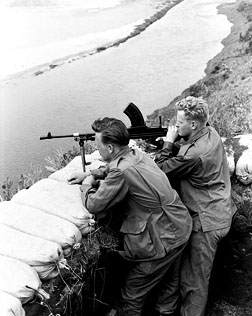
24-25 April 1951
Beginning after nightfall on 24 April and lasting until dawn on 25 April, Chinese troops surround and attack the 2 PPCLI positions on Hill 677 in the Kapyong River valley, but the defenders manage to hold their ground at the cost of 10 dead and 23 wounded.
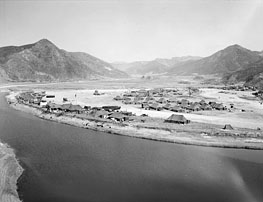
1 May 1951
The Chinese offensive is halted north of Seoul.

4-6 May 1951
The Canadian brigade arrives in Busan to join 2 PPCLI in Korea.
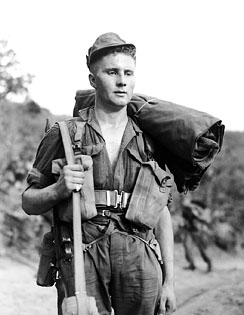
16 May 1951
The Chinese launch the second part of their spring offensive along eastern sector of front and is again stopped by UN forces.
22 May 1951
The Canadian brigade joins in UN advance east of Seoul.
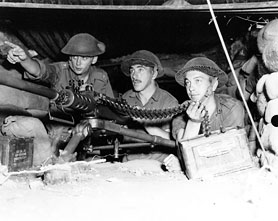
27 May 1951
The Canadian brigade reaches the 38th Parallel.
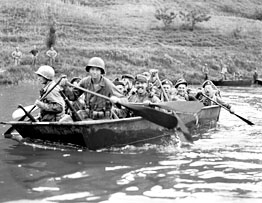
29-30 May 1951
Canadian troops attack Kakhul-bong, or Hill 467, and Chinese defences around the village of Chail-li. Although they capture the village, the Canadians are forced to withdraw after fresh Chinese troops infiltrate their positions. The effort costs 6 lives and 25 wounded. Six days later, an American regimental combat team occupies Chail-li as the Chinese continue their withdrawal into North Korea.

21 June 1951
After the Canadian brigade moves to Chorwon, 2 RCR commences the first of many Canadian patrols in the area. Enemy opposition to these patrols is usually light but inflicts some casualties.
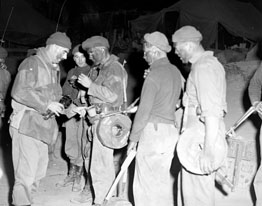
23 June 1951
Cease-fire negotiations are proposed by the Soviet delegate to the UN Security Council.
29-30 June 1951
General Ridgway is directed by the US chiefs of staff to initiate discussions with the enemy concerning the possibility of holding talks and radios a message to Pyongyang. A joint response from Kim Il-sung and General P'eng, commander-in-chief of the Chinese army, indicates they agree to engage in talks and also select the location: a tea-house at Kaesong, just above the 38th Parallel in Communist-held territory.

10 July 1951
Peace negotiations begin at Kaesong between the Communists and a delegation of the UN Security Council. It soon becomes clear that the Chinese expect the UN to surrender.
18-19 July 1951
2 R22eR take over advanced patrol bases on the Imjin river's west bank north of the Imjin-Hantan rivers confluence. Two ferries crossing the river are inoperable because of flooding, trapping the Canadians as they are attacked by Chinese troops. The attack leaves two Canadians dead and one wounded. The remaining troops are evacuated on 23 and 24 July 1951.

26 July 1951
The UN and Communist delegations reach an agreement on the agenda for the armistice talks.
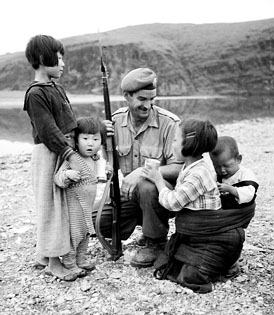
28 July 1951
The 1st Commonwealth Division is formed by joining the Canadian, British and Commonwealth brigades operating in Korea.
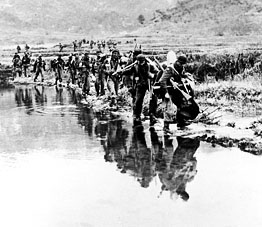
9 August 1951
HMCS Cayuga is assigned to patrol the waters around the islands of Ch'o-do and Sok-to located west off the Korean coast and above the 38th Parallel. The islands are used as bases for intelligence teams, guerrilla operations, and radio stations guiding US bombing and fighter missions.
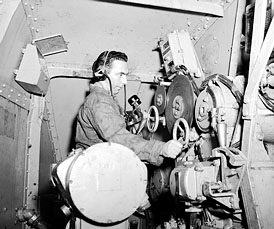
10 August 1951
Negotiations between the Communist and UN delegations deteriorate and reach a low point, which is evident when the delegations stare across the table at each other in complete silence for two hours and eleven minutes. Two weeks later negotiations between the Communist and UN delegations are suspended after the Americans are accused of dropping a napalm bomb within the designated neutral conference area during the night.
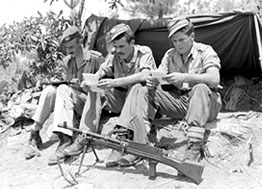
23 August 1951
General Ridgway orders a limited offensive on the Communist forces, alarming the Communists and leading them to propose a continuation of talks in Panmunjom, a deserted hamlet in no man's land about 8 kilometres east of Kaesong.
5 September 1951
The North Koreans are driven off "Bloody Ridge" after 3 weeks of hard fighting and the expenditure of nearly half a million artillery rounds. The battle east of the Hwach'on Reservoir costs the UN forces over 2700 casualties and the enemy an estimated 15,000.
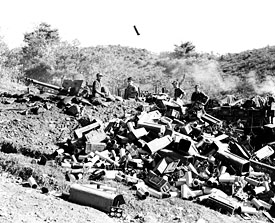
8 September 1951
The Canadian brigade is involved in Operation Minden in which the Commonwealth Division advances to higher ground across the Imjin River in order to improve positions on a new front line. R22eR wins two Military Crosses and two Military Medals during this operation.
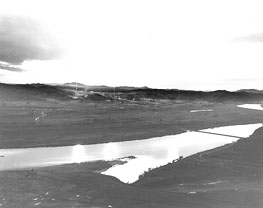
13 September 1951
The Battle of "Heartbreak Ridge", the next ridge to the north of "Bloody Ridge", is launched by the 2nd US Infantry Division north of the 38th parallel. After 30 days of combat, this area is secured by the Americans on 15 October 1951 at a cost of 3745 casualties. Because both sides suffer heavily, it is the last major offensive conducted by UN forces in the war.
3 October 1951
The 1st Commonwealth Division begins Operation Commando, in which five US-led 1st Corps divisions advance to establish a new front along the "Jamestown" Line.
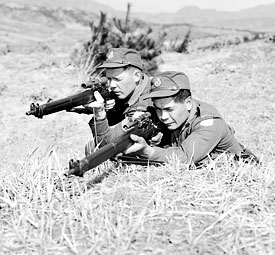
4 October 1951
As part of the Canadian brigade's advance, 2 PPCLI attack Chinese positions atop Hill 187. After a two hour fight, 28 Chinese are killed and four are taken prisoner for the loss of one PPCLI soldier killed and ten wounded. The positions seized by the Canadians are on a line of hills overlooking the Sami-ch'on River and a smaller valley, the Nabu-ri, to its north.
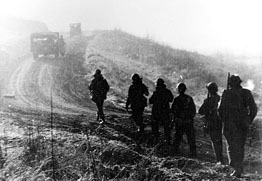
5 October 1951
Troops of the 1st Battalion, PPCLI, arrive in Busan, Korea to replace 2 PPCLI after a year of service in Korea. This commences the first Canadian troop rotations in Korea.
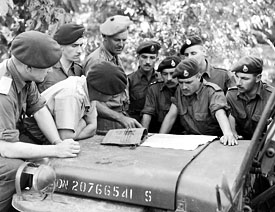
9 October 1951
With the capture of Hill 317 by the Australians, Operation Commando is completed at a cost of 58 Commonwealth soldiers killed and 262 wounded. The Canadian brigade has lost 4 killed in action and 28 wounded in the operation. With Commando's conclusion, the Commonwealth Division has reached the positions that it will hold for the remainder of the Korean War.

23 October 1951
The Canadian brigade launches Operation Pepperpot, a raid meant to inflict damage and casualties on the enemy and obtain information about the layout of their positions. One company from each of the three infantry battalions - the PPCLI, the RCR, and the R22eR - attack Hills 166 and 156 across the Nabu-ri valley and achieve most of their objectives. Five Canadian soldiers are killed and 21 wounded; the enemy lost 37 known dead, and as many more are believed killed or wounded.
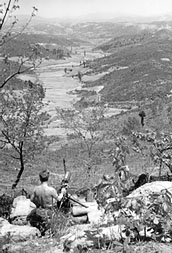
25 October 1951
Cease-fire discussions resume at Panmunjom between the Communist and UN delegations, while the two sides engage in a bloody stalemate along the 38th Parallel.

2 November 1951
Chinese forces open a counter-offensive to retake some of the positions lost to the Commonwealth Division during Operation Commando. As a diversion to the coming attacks to the north, a Chinese battalion raids a 2 RCR platoon position on the Songgok feature, southwest of Hill 187, killing at least 35 Chinese and taking two wounded prisoners for the loss of one Canadian soldier dead and 13 wounded.
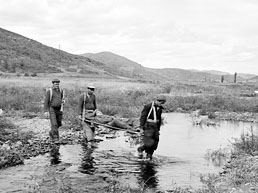
13 November 1951
The demarcation line is established provided outstanding issues at truce talks are settled within 30 days. The UN ground action is permitted to continue.

22-24 November 1951
Members of 'D' Company, 2 R22eR hold their ground on the western slope of Hill 355, the key feature north of the Imjin River, after a heavy Chinese attack drives the American battalion holding the summit off the feature. The subsequent US counterattack to recapture Hill 355 is made easier by the 2 R22eR's stubborn defence. The action costs the battalion 16 dead, 44 wounded and three captured.

24 November 1951
The three members of 2 R22eR that were taken prisoner by the Chinese during the fight for Hill 355 are the first Canadian soldiers to suffer that misfortune in Korea. They are imprisoned in camps in North Korea administered by the Chinese.
10-11 December 1951
Troops of 1 PPCLI, raid Hill 227, 1500 metres west of Hill 355, destroying enemy bunkers and machine gun positions. The raid leads to one killed and 30 wounded. Fighting and ambush patrols increase with the aim of capturing Chinese.
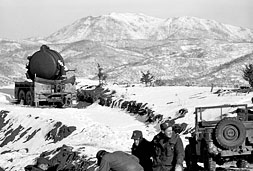
27 December 1951
The demarcation line is invalidated as 30 days have passed and no progress is made on outstanding issues. The static war continues with little movement on either side.

- Date modified: